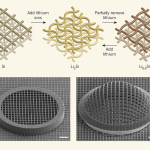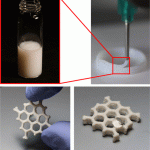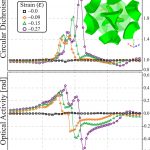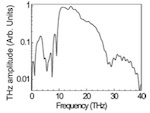Publications
Jeon, S. -Y.; Kang, S. H.
Electrochemical reactions drive morphing of materials Journal Article
In: Nature, vol. 573, pp. 198-199, 2019.
@article{Jeon2019,
title = {Electrochemical reactions drive morphing of materials},
author = {S.-Y. Jeon and S. H. Kang},
url = {https://www.nature.com/articles/d41586-019-02663-9},
doi = {10.1038/d41586-019-02663-9},
year = {2019},
date = {2019-09-11},
journal = {Nature},
volume = {573},
pages = {198-199},
abstract = {Silicon anodes in lithium batteries expand during discharge, causing failure. This expansion has been used constructively in a material whose architecture controllably and reversibly changes to alter its function.},
keywords = {},
pubstate = {published},
tppubtype = {article}
}
Jiang, Zhuoran; Erol, Ozn; Chatterjee, Devina; Xu, Weinan; Hibino, Narutoshi; Romer, Lewis H.; Kang, Sung Hoon; Gracias, David H.
Direct Ink Writing of Poly(tetrafluoroethylene) (PTFE) with Tunable Mechanical Properties Journal Article
In: ACS Applied Materials and Interfaces, 2019.
@article{Jiang2019,
title = {Direct Ink Writing of Poly(tetrafluoroethylene) (PTFE) with Tunable Mechanical Properties},
author = {Zhuoran Jiang and Ozn Erol and Devina Chatterjee and Weinan Xu and Narutoshi Hibino and Lewis H. Romer and Sung Hoon Kang and David H. Gracias},
url = {https://doi.org/10.1021/acsami.9b07279},
doi = {10.1021/acsami.9b07279},
year = {2019},
date = {2019-07-10},
journal = {ACS Applied Materials and Interfaces},
abstract = {Poly(tetrafluoroethylene) (PTFE) is a unique polymer with highly desirable properties such as resistance to chemical degradation, biocompatibility, hydrophobicity, antistiction, and low friction coefficient. However, due to its high melt viscosity, it is not possible to three-dimensional (3D)-print PTFE structures using nozzle-based extrusion. Here, we report a new and versatile strategy for 3D-printing PTFE structures using direct ink writing (DIW). Our approach is based on a newly formulated PTFE nanoparticle ink and thermal treatment process. The ink was formulated by mixing an aqueous dispersion of surfactant-stabilized PTFE nanoparticles with a binding gum to optimize its shear-thinning properties required for DIW. We developed a multistage thermal treatment to fuse the PTFE nanoparticles, solidify the printed structures, and remove the additives. We have extensively characterized the rheological and mechanical properties and processing parameters of these structures using imaging, mechanical testing, and statistical design of experiments. Importantly, several of the mechanical and structural properties of the final-printed PTFE structures resemble that of compression-molded PTFE, and additionally, the mechanical properties are tunable. We anticipate that this versatile approach facilitates the production of 3D-printed PTFE components using DIW with significant potential applications in engineering and medicine.},
keywords = {},
pubstate = {published},
tppubtype = {article}
}
Zárate, Yair; Babaee, Sahab; Kang, Sung H.; Neshev, Dragomir N.; Shadrivov, Ilya V.; Bertoldi, Katia; Powell, David A.
Elastic metamaterials for tuning circular polarization of electromagnetic waves Journal Article
In: Scientific Reports, vol. 6, pp. 28273, 2016.
@article{Zárate2016,
title = {Elastic metamaterials for tuning circular polarization of electromagnetic waves},
author = {Yair Zárate and Sahab Babaee and Sung H. Kang and Dragomir N. Neshev and Ilya V. Shadrivov and Katia Bertoldi and David A. Powell},
url = {http://www.nature.com/articles/srep28273},
doi = {doi:10.1038/srep28273},
year = {2016},
date = {2016-06-20},
journal = {Scientific Reports},
volume = {6},
pages = {28273},
abstract = {Electromagnetic resonators are integrated with advanced elastic material to develop a new type of tunable metamaterial. An electromagnetic-elastic metamaterial able to switch on and off its electromagnetic chiral response is experimentally demonstrated. Such tunability is attained by harnessing the unique buckling properties of auxetic elastic materials (buckliballs) with embedded electromagnetic resonators. In these structures, simple uniaxial compression results in a complex but controlled pattern of deformation, resulting in a shift of its electromagnetic resonance, and in the structure transforming to a chiral state. The concept can be extended to the tuning of three-dimensional materials constructed from the meta-molecules, since all the components twist and deform into the same chiral configuration when compressed.},
keywords = {},
pubstate = {published},
tppubtype = {article}
}
Mandal, Krishna C.; Kang, Sung Hoon; Choi, Michael; Chen, Jian; Zhang, Xi-Cheng; Schleicher, James M.; Schmuttenmaer, Charles A.; Fernelius, Nils C.
III–VI Chalcogenide Semiconductor Crystals for Broadband Tunable THz Sources and Sensors Journal Article
In: IEEE Journal of Selected Topics in Quantum Electronics, vol. 14, pp. 284 – 288, 2008.
@article{Mandal2008,
title = {III–VI Chalcogenide Semiconductor Crystals for Broadband Tunable THz Sources and Sensors},
author = {Krishna C. Mandal and Sung Hoon Kang and Michael Choi and Jian Chen and Xi-Cheng Zhang and James M. Schleicher and Charles A. Schmuttenmaer and Nils C. Fernelius},
url = {http://ieeexplore.ieee.org/xpl/articleDetails.jsp?reload=true&arnumber=4481122},
year = {2008},
date = {2008-04-04},
journal = {IEEE Journal of Selected Topics in Quantum Electronics},
volume = {14},
pages = {284 - 288},
abstract = {The layered chalcogenide semiconductor GaSe has been grown under various crystal growth conditions for optimum performance for tunable terahertz (THz) wave generation and broadband THz detection. Low-temperature photoluminescence (PL), Raman spectroscopy, optical absorption/transmission, electrical charge transport property measurements, and THz time-domain spectroscopy (TDS) have been used to characterize the grown crystals. It is observed that indium doping enhances hardness of the grown GaSe crystals, which is very useful for processing and fabricating large-area devices. GaSe crystals have demonstrated promising characteristics with good optical quality (absorption coefficient les0.1 cm-1 in the spectral range of 0.62-18 mum), high dark resistivity (ges109 Omega cm), wide bandgap (2.01 eV at 300 K), good anisotropic (parand perp) electrical transport properties (mue/h, taue/h, and mutaue/h) and long-term stability. The THz emission measurements have shown that the GaSe crystals are highly efficient for broadband tunable THz sources (up to 40 THz), and sensors (up to 100 THz). Additionally, new THz frequencies (0.1-3 THz) have been observed for the first time from an anisotropic binary and a ternary semiconductor crystal. Details of characterizations as well as optimum crystal growth conditions including simulation and computer modeling are described in this paper.},
keywords = {},
pubstate = {published},
tppubtype = {article}
}
Note: Send e-mail to Prof. Kang at shkang@jhu.edu if you need a pdf file of the papers below.
2019

Jeon, S. -Y.; Kang, S. H.
Electrochemical reactions drive morphing of materials Journal Article
In: Nature, vol. 573, pp. 198-199, 2019.
Abstract | Links | BibTeX | Tags: 3D printing, architected materials, shape, Tunable
@article{Jeon2019,
title = {Electrochemical reactions drive morphing of materials},
author = {S.-Y. Jeon and S. H. Kang},
url = {https://www.nature.com/articles/d41586-019-02663-9},
doi = {10.1038/d41586-019-02663-9},
year = {2019},
date = {2019-09-11},
journal = {Nature},
volume = {573},
pages = {198-199},
abstract = {Silicon anodes in lithium batteries expand during discharge, causing failure. This expansion has been used constructively in a material whose architecture controllably and reversibly changes to alter its function.},
keywords = {3D printing, architected materials, shape, Tunable},
pubstate = {published},
tppubtype = {article}
}

Jiang, Zhuoran; Erol, Ozn; Chatterjee, Devina; Xu, Weinan; Hibino, Narutoshi; Romer, Lewis H.; Kang, Sung Hoon; Gracias, David H.
Direct Ink Writing of Poly(tetrafluoroethylene) (PTFE) with Tunable Mechanical Properties Journal Article
In: ACS Applied Materials and Interfaces, 2019.
Abstract | Links | BibTeX | Tags: 3D printing, additive manufacturing, composites, fluoropolymer, PTFE, Teflon, Tunable
@article{Jiang2019,
title = {Direct Ink Writing of Poly(tetrafluoroethylene) (PTFE) with Tunable Mechanical Properties},
author = {Zhuoran Jiang and Ozn Erol and Devina Chatterjee and Weinan Xu and Narutoshi Hibino and Lewis H. Romer and Sung Hoon Kang and David H. Gracias},
url = {https://doi.org/10.1021/acsami.9b07279},
doi = {10.1021/acsami.9b07279},
year = {2019},
date = {2019-07-10},
journal = {ACS Applied Materials and Interfaces},
abstract = {Poly(tetrafluoroethylene) (PTFE) is a unique polymer with highly desirable properties such as resistance to chemical degradation, biocompatibility, hydrophobicity, antistiction, and low friction coefficient. However, due to its high melt viscosity, it is not possible to three-dimensional (3D)-print PTFE structures using nozzle-based extrusion. Here, we report a new and versatile strategy for 3D-printing PTFE structures using direct ink writing (DIW). Our approach is based on a newly formulated PTFE nanoparticle ink and thermal treatment process. The ink was formulated by mixing an aqueous dispersion of surfactant-stabilized PTFE nanoparticles with a binding gum to optimize its shear-thinning properties required for DIW. We developed a multistage thermal treatment to fuse the PTFE nanoparticles, solidify the printed structures, and remove the additives. We have extensively characterized the rheological and mechanical properties and processing parameters of these structures using imaging, mechanical testing, and statistical design of experiments. Importantly, several of the mechanical and structural properties of the final-printed PTFE structures resemble that of compression-molded PTFE, and additionally, the mechanical properties are tunable. We anticipate that this versatile approach facilitates the production of 3D-printed PTFE components using DIW with significant potential applications in engineering and medicine.},
keywords = {3D printing, additive manufacturing, composites, fluoropolymer, PTFE, Teflon, Tunable},
pubstate = {published},
tppubtype = {article}
}
2016

Zárate, Yair; Babaee, Sahab; Kang, Sung H.; Neshev, Dragomir N.; Shadrivov, Ilya V.; Bertoldi, Katia; Powell, David A.
Elastic metamaterials for tuning circular polarization of electromagnetic waves Journal Article
In: Scientific Reports, vol. 6, pp. 28273, 2016.
Abstract | Links | BibTeX | Tags: 3D printing, Auxetic, buckling, Chiral, electromagnetic, Metamaterial, Tunable
@article{Zárate2016,
title = {Elastic metamaterials for tuning circular polarization of electromagnetic waves},
author = {Yair Zárate and Sahab Babaee and Sung H. Kang and Dragomir N. Neshev and Ilya V. Shadrivov and Katia Bertoldi and David A. Powell},
url = {http://www.nature.com/articles/srep28273},
doi = {doi:10.1038/srep28273},
year = {2016},
date = {2016-06-20},
journal = {Scientific Reports},
volume = {6},
pages = {28273},
abstract = {Electromagnetic resonators are integrated with advanced elastic material to develop a new type of tunable metamaterial. An electromagnetic-elastic metamaterial able to switch on and off its electromagnetic chiral response is experimentally demonstrated. Such tunability is attained by harnessing the unique buckling properties of auxetic elastic materials (buckliballs) with embedded electromagnetic resonators. In these structures, simple uniaxial compression results in a complex but controlled pattern of deformation, resulting in a shift of its electromagnetic resonance, and in the structure transforming to a chiral state. The concept can be extended to the tuning of three-dimensional materials constructed from the meta-molecules, since all the components twist and deform into the same chiral configuration when compressed.},
keywords = {3D printing, Auxetic, buckling, Chiral, electromagnetic, Metamaterial, Tunable},
pubstate = {published},
tppubtype = {article}
}
2008

Mandal, Krishna C.; Kang, Sung Hoon; Choi, Michael; Chen, Jian; Zhang, Xi-Cheng; Schleicher, James M.; Schmuttenmaer, Charles A.; Fernelius, Nils C.
III–VI Chalcogenide Semiconductor Crystals for Broadband Tunable THz Sources and Sensors Journal Article
In: IEEE Journal of Selected Topics in Quantum Electronics, vol. 14, pp. 284 – 288, 2008.
Abstract | Links | BibTeX | Tags: Broadband, Chalcogenide, Crystal, III-VI, Semiconductor, Sensor, Source, THz, Tunable
@article{Mandal2008,
title = {III–VI Chalcogenide Semiconductor Crystals for Broadband Tunable THz Sources and Sensors},
author = {Krishna C. Mandal and Sung Hoon Kang and Michael Choi and Jian Chen and Xi-Cheng Zhang and James M. Schleicher and Charles A. Schmuttenmaer and Nils C. Fernelius},
url = {http://ieeexplore.ieee.org/xpl/articleDetails.jsp?reload=true&arnumber=4481122},
year = {2008},
date = {2008-04-04},
journal = {IEEE Journal of Selected Topics in Quantum Electronics},
volume = {14},
pages = {284 - 288},
abstract = {The layered chalcogenide semiconductor GaSe has been grown under various crystal growth conditions for optimum performance for tunable terahertz (THz) wave generation and broadband THz detection. Low-temperature photoluminescence (PL), Raman spectroscopy, optical absorption/transmission, electrical charge transport property measurements, and THz time-domain spectroscopy (TDS) have been used to characterize the grown crystals. It is observed that indium doping enhances hardness of the grown GaSe crystals, which is very useful for processing and fabricating large-area devices. GaSe crystals have demonstrated promising characteristics with good optical quality (absorption coefficient les0.1 cm-1 in the spectral range of 0.62-18 mum), high dark resistivity (ges109 Omega cm), wide bandgap (2.01 eV at 300 K), good anisotropic (parand perp) electrical transport properties (mue/h, taue/h, and mutaue/h) and long-term stability. The THz emission measurements have shown that the GaSe crystals are highly efficient for broadband tunable THz sources (up to 40 THz), and sensors (up to 100 THz). Additionally, new THz frequencies (0.1-3 THz) have been observed for the first time from an anisotropic binary and a ternary semiconductor crystal. Details of characterizations as well as optimum crystal growth conditions including simulation and computer modeling are described in this paper.},
keywords = {Broadband, Chalcogenide, Crystal, III-VI, Semiconductor, Sensor, Source, THz, Tunable},
pubstate = {published},
tppubtype = {article}
}